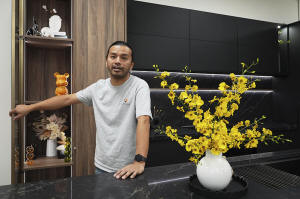Kitchen cabinet companies hope new US tariffs pay off in the long run
[October 14, 2025] By
MAE ANDERSON
NEW YORK (AP) — Cabinet dealers, interior designers and remodeling
contractors in the U.S. hope new tariffs on imported kitchen cabinets,
bathroom vanities and upholstered wooden furniture that kicked in
Tuesday will create more business for them and eventually boost domestic
production of those products.
But several small business owners in the home improvement industry say
they expect some short-term pains from the import taxes: Clients with
projects already on the books might balk at having to pay more for the
budget-priced cabinets they selected. Potential customers may postpone
kitchen and bathroom renovations until costs — and the economy — seem
more stable.
“I think the volatility around pricing is damaging to the remodeling
industry,” said Allison Harlow, an interior designer in Michigan whose
company, Curio Design Studio, creates and builds custom bathrooms and
kitchens. “Most people will hear the headline of ‘Kitchen cabinets will
go up 50%’ and might just opt out of even reaching out to our company.”
Despite high mortgage rates having depressed sales of existing homes in
recent years, a forecast of remodeling activity by Harvard University's
Joint Center for Housing Studies predicts that homeowner spending on
improvements and maintenance will remain steady into the middle of 2026.
Trump calls cheap imports a national security threat
A proclamation that President Donald Trump signed on Sept. 29 cited
national security and foreign trade practices as grounds for imposing
the tariffs on certain finished wood products and product components.

Of them, imported vanities and kitchen cabinets incurred the steepest
tax rates: 25% until the end of the year and 50% starting on New Year’s
Day.
Upholstered chairs, seats and sofas also are subject to a 25% worldwide
tariff effective Tuesday, with the rate scheduled to increase to 30% on
Jan. 1. In addition, the presidential proclamation put a 10% import tax
on softwood timber and lumber, which comes from evergreen trees like
pine and cedars.
Softwoods often are used to make furniture and in wood frame
construction. Canada is the source of about 85% of the softwood lumber
the U.S. imports, or nearly one-quarter of the national supply,
according to the National Association of Homebuilders.
Some U.S. trading partners are receiving more favorable treatment when
it comes to the furniture and cabinetry tariffs. The tax on U.K. exports
was capped at 10%, while the rate for wood products from the European
Union and Japan was capped at 15%.
The American Kitchen Cabinet Alliance and other trade and advocacy
groups lobbied for tariffs to help offset what they described as a flood
of cheap cabinets from countries such as Vietnam, Malaysia, China and
elsewhere in the decades since more U.S. furniture manufacturing moved
offshore.
U.S.-made products tend to cost more but often are of better quality.
A higher bottom line for renovators on a budget
John Lovallo, an analyst at UBS bank, estimates the tariffs on imported
cabinets and vanities could add roughly $280 to the average cost of
building a single-family home, not enough to sink a project that often
carries an overall price tag more than 1,000 times larger than that.
Some business owners say they plan to cover any tariff-related costs for
now instead of raising customer prices.
John Dean, founder of Dean Cabinetry in Connecticut, sells cabinets that
run the gamut from lower-priced imports to custom models made in his
shop. Imported products account for about a third of his sales, but Dean
said he does not expect much fallout from the tariffs.

[to top of second column] |

Josh Qian, co-founder of Linq Kitchen, a designer and maker of
kitchen cabinets, shows his company's show room and warehouse in
City of Industry, Calif., Friday, Oct. 10, 2025. (AP Photo/Damian
Dovarganes)
 Two of his vendors that he buys
imported cabinets from, in China and Vietnam, said they would raise
prices by 10% to recoup some of the duty costs.
Dean said he would not charge customers more for now. Since a
kitchen remodel is a big ticket item to begin with, and with the
costs of building lumber and labor going up, raising cabinet prices
might hurt demand, he said.
“My personal perspective is most small- and medium-sized businesses
are trying to absorb those costs," he said.
The wood product tariffs are likely to have a bigger effect on
selection than on prices as importers scale back their orders to
focus on bestsellers and products with the highest profit margins,
according to Jason Miller, a supply chain management professor at
Michigan State University.
“It will make importers more selective in the varieties they bring
in,” Miller said: “So I think the bigger impact is going to be on
the product variety side: Consumers should expect less variety.”
What cabinet companies are expecting
Although the White House said the tariffs were intended to boost
domestic production and protect U.S. businesses from predatory trade
practices, some cabinet makers say that will be difficult because
their supply chains are multinational.
Linq Kitchen, a Los Angeles-area company that designs, builds and
installs modern-style kitchen cabinets, uses plywood and melamine
panels from Asia and Europe in its projects, co-founder Josh Qian
said. A suitable domestic alternative does not exist, he said.
“The kitchen cabinet industry is highly globalized, and even
U.S.-based manufacturers depend on imported materials, hardware, and
finishes,” Qian said. “These tariffs may sound protective, but in
reality, they often raise costs across the entire supply chain."

At the same time, cabinet companies that don't sell foreign products
or rely on imported components look forward to capturing more
business. One is ACO Denver Custom Cabinetry in Denver, Colorado,
which enlists Amish, Mennonite, and New German Baptist shops in the
Midwest to handcraft custom cabinets.
Andrea Mulkey, the company's president and co-founder, said her main
concern is whether interest in American-made cabinets will grow too
quickly.
“It’s hard to predict how much new business might come our way as
competitors are affected,” Mulkey said. “We simply couldn’t serve
everyone if demand suddenly surged. The real challenge is similar to
what we saw post-COVID, when everyone got busy at once, and access
to raw materials became strained.”
The Curio Design Studio has its custom cabinets made in Minnesota
and Wisconsin, but Harlow worries about the tariffs costing her
customers.
“I think it will decrease consumer confidence and create a narrative
that the work is going to get inherently more expensive,” Harlow
said. “I think we will have to work harder to attract potential
clients with messaging of how this blanket statement, ‘Kitchen
cabinets will go up 50%,’ does not impact our particular business
model.”
All contents © copyright 2025 Associated Press. All rights reserved |